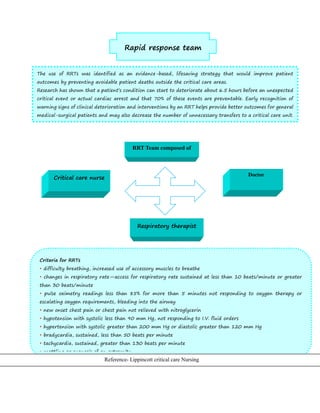RRT.doc
- 1. Rapid response team The use of RRTs was identified as an evidence-based, lifesaving strategy that would improve patient outcomes by preventing avoidable patient deaths outside the critical care areas. Research has shown that a patientŌĆÖs condition can start to deteriorate about 6.5 hours before an unexpected critical event or actual cardiac arrest and that 70% of these events are preventable. Early recognition of warning signs of clinical deterioration and interventions by an RRT helps provide better outcomes for general medical-surgical patients and may also decrease the number of unnecessary transfers to a critical care unit. Critical care nurse Doctor RRT Team composed of Respiratory therapist Criteria for RRTs ŌĆó difficulty breathing, increased use of accessory muscles to breathe ŌĆó changes in respiratory rateŌĆöaccess for respiratory rate sustained at less than 10 beats/minute or greater than 30 beats/minute ŌĆó pulse oximetry readings less than 85% for more than 5 minutes not responding to oxygen therapy or escalating oxygen requirements, bleeding into the airway ŌĆó new onset chest pain or chest pain not relieved with nitroglycerin ŌĆó hypotension with systolic less than 90 mm Hg, not responding to I.V. fluid orders ŌĆó hypertension with systolic greater than 200 mm Hg or diastolic greater than 120 mm Hg ŌĆó bradycardia, sustained, less than 50 beats per minute ŌĆó tachycardia, sustained, greater than 130 beats per minute ŌĆó mottling or cyanosis of an extremity ŌĆó change in level of consciousness or seizure ŌĆó stroke symptomsŌĆöchanges in vision, loss of speech, weakness of an extremity ŌĆó sepsis or systemic inflammatory response syndrome (SIRS) ŌĆó uncontrolled bleeding from the surgical site or lower GI tract. Reference- Lippincott critical care Nursing
